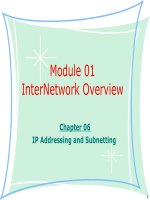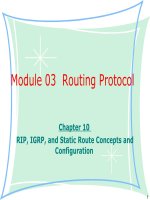Lecture CCNA security partner - Chapter 9: Firewall Fundamentals and Network Address Translation
Bạn đang xem bản rút gọn của tài liệu. Xem và tải ngay bản đầy đủ của tài liệu tại đây (684.76 KB, 29 trang )
Firewall Fundamentals and Network
Address Translation
© 2012 Cisco and/or its affiliates. All rights reserved.
1
Ethics
• The information security profession has a number of formalized codes:
–
International Information Systems Security Certification Consortium, Inc
(ISC)2 Code of Ethics
–
Computer Ethics Institute (CEI)
–
Internet Activities Board (IAB)
–
Generally Accepted System Security Principles (GASSP)
© 2012 Cisco and/or its affiliates. All rights reserved.
2
Contents
This chapter teaches firewall concepts, technologies, and design
principles. At the end of this chapter, you will be able to do the following:
• Explain the operations of the different types of firewall technologies
• Describe firewall technologies that historically have played, and still play,
a role in network access control and security architectures
• Introduce and describe the function and building blocks of Network
Address Translation
• List design considerations for firewall deployment
• Describe guidelines for firewall ruleset creation
© 2012 Cisco and/or its affiliates. All rights reserved.
3
Introducing Firewall Technologies
• A firewall protects network devices from intentional, hostile intrusions
that could threaten information assurance (availability, confidentiality,
and integrity) or lead to a denial-of-service (DoS) attack.
• A firewall can protect a hardware device or a software program running
on a secure host computer.
• This chapter introduces the firewall technologies that Cisco uses in
routers and security appliances.
© 2012 Cisco and/or its affiliates. All rights reserved.
4
Firewall Fundamentals
A firewall is a pair of mechanisms that perform these two separate
functions, which are set by policies:
• One mechanism blocks bad traffic.
• The second mechanism permits good traffic.
Firewall: Enforcing Access Control
© 2012 Cisco and/or its affiliates. All rights reserved.
5
Common properties
• Must be resistant to attacks
• Must be the only transit point between networks
• Enforces the access control policy of an organization
Protective measure against the following :
• Exposure of sensitive hosts and applications to untrusted users
• Exploitation of protocol flaws
• Malicious data
© 2012 Cisco and/or its affiliates. All rights reserved.
6
Firewalls in a Layered Defense Strategy
© 2012 Cisco and/or its affiliates. All rights reserved.
7
Static Packet-Filtering Firewalls
How Static Packet Filters Map to the OSI Model
© 2012 Cisco and/or its affiliates. All rights reserved.
8
Static Packet Filter in Action
© 2012 Cisco and/or its affiliates. All rights reserved.
9
Application Layer Gateways
© 2012 Cisco and/or its affiliates. All rights reserved.
10
Application layer firewalls
Application layer firewalls provide several advantages:
• Application layer firewalls authenticate individuals, not devices
• Application layer firewalls make it is harder for hackers to spoof and
implement DoS attacks
• Application layer firewalls can monitor and filter application data
• Application layer firewalls can provide detailed logging
© 2012 Cisco and/or its affiliates. All rights reserved.
11
Proxy Server Communication Process
© 2012 Cisco and/or its affiliates. All rights reserved.
12
Dynamic or Stateful Packet-Filtering
Firewalls
© 2012 Cisco and/or its affiliates. All rights reserved.
13
Stateful Packet Filtering
© 2012 Cisco and/or its affiliates. All rights reserved.
14
Advanced
Stateful packet-filtering firewalls are good to use for the following
applications:
• As a primary means of defense
• As an intelligent first line of defense
• As a means of strengthening packet filtering
• To improve routing performance
• As a defense against spoofing and DoS attacks
© 2012 Cisco and/or its affiliates. All rights reserved.
15
Limited
Stateful firewalls have the following limitations:
• Stateful firewalls cannot prevent application layer attacks
• Not all protocols have a state
• Some applications open multiple connections
• Stateful firewalls do not authenticate users by default
© 2012 Cisco and/or its affiliates. All rights reserved.
16
Other Types of Firewalls
• Application Inspection Firewalls, aka Deep Packet Inspection
• An application inspection firewall behaves in different ways according to
each layer:
• Transport layer mechanism
• Application layer mechanism
There are several advantages of an application inspection firewall:
• Application inspection firewalls are aware of the state of Layer 4 and
Layer 5 connections.
• Application inspection firewalls check the conformity of application
commands.
• Application inspection firewalls have the capability to check and affect
Layer 7.
• Application inspection firewalls can prevent more kinds of attacks than
stateful firewalls can.
© 2012 Cisco and/or its affiliates. All rights reserved.
17
Transparent Firewalls (Layer 2 Firewalls)
Transparent Firewalling:
Firewall Interfaces All in
the Same Subnet
• Cisco IOS routers, Cisco ASA Adaptive Security Appliance Software,
Cisco Firewall Services Module, and Cisco ASA Services Module offer
the capability to deploy a security appliance in a secure bridging mode
as a Layer 2 device to provide rich Layer 2 through 7 security services
for the protected network
© 2012 Cisco and/or its affiliates. All rights reserved.
18
NAT Fundamentals
Example of Network Address Translation
© 2012 Cisco and/or its affiliates. All rights reserved.
19
NAT table
Cisco defines the following list of NAT terms:
• Inside local address
• Inside global address
• Outside local address
• Outside global address
© 2012 Cisco and/or its affiliates. All rights reserved.
20
Example of Port Address Translation
(aka NAT Overload) on Cisco IOS Router
© 2012 Cisco and/or its affiliates. All rights reserved.
21
Translating Inside Source Address
© 2012 Cisco and/or its affiliates. All rights reserved.
22
Static Translation
© 2012 Cisco and/or its affiliates. All rights reserved.
23
NAT Deployment Choices
The deployment modes in NAT operations are as follows:
• Static NAT
• Dynamic NAT
• Dynamic PAT (NAT overload)
• Policy NAT
• Static PAT
© 2012 Cisco and/or its affiliates. All rights reserved.
24
Firewall Designs
Best practices documents are a composite effort of security practitioners.
This partial list of best practices is generic and serves only as a starting
point for your own firewall security policy:
• Position firewalls at key security boundaries, separating security domains
with different levels of trust.
• Firewalls are the primary security device, but it is unwise to rely
exclusively on a firewall for security.
• Deny all traffic by default and permit only services that are needed.
• Implement various firewall technologies, matching your application mix
and security policy requirements.
• Ensure that physical access to the firewall is controlled.
• Regularly monitor firewall logs. Cisco Security Manager and other Cisco
management tools are available for this purpose.
• Practice change management for firewall configuration changes.
© 2012 Cisco and/or its affiliates. All rights reserved.
25









